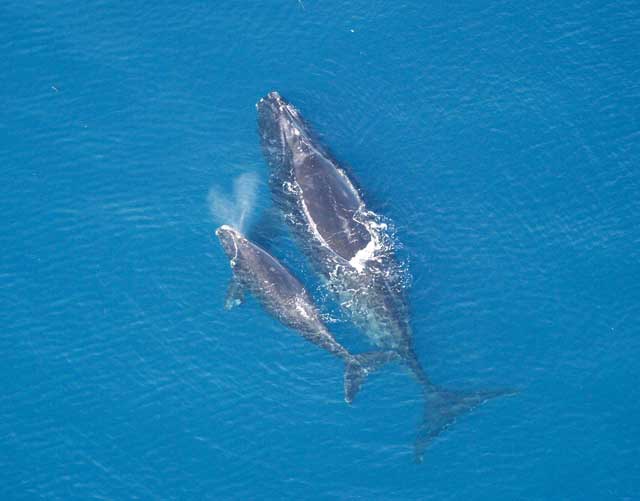Slow Down: Whale Crossing

The thirteen buoys of the Right Whale Listening Network listen for endangered right whales crossing shipping channels, and provide a warning to ships to slow down. The smart buoys were developed at the Cornell Lab of Ornithology and Woods Hole Oceanographic Institution
The busy shipping lanes in Massachusetts Bay (and elsewhere along the east coast) have been the site of deadly collisions between the gentle whales and merchant ships. The Right Whale Listening Network uses auto-detection smart buoys with a listening radius of five miles to recognize the right whale's call; the buoys record the sound and upload it to the network's website and to the Northeast U.S. Right Whale Sighting Advisory System, operated by the National Oceanic and Atmospheric Administration (NOAA).
Ship captains can view a near-real-time graphic that shows the positions of recently recorded whale sounds. It takes as little as twenty minutes for a buoy to detect a right whale, and then update the warning system.
Only about 400 right whales remain; the Listening Network was specifically designed in response to the development of a new liquefied natural gas terminal built offshore of Boston. NOAA mandated the development of the system to prevent collisions between 70 ton right whales and 90,000 ton supply tankers. The whales are also a source of tourist-related revenue for the region; see this right whale video.
The Lab or Ornithology will operate the buoy array over the expected 40 year life of the gas terminal under a $47 million contract. LNG tankers must slow to 10 knots in response to buoy alerts.
"For the first time, we can go online and hear up-to-the-minute voices of calling whales, and see where those whales are in the ocean off Boston and Cape Cod," said Christopher Clark, director of the Bioacoustics Research Program at the Lab of Ornithology. "Better yet, those calls immediately get put to use in the form of timely warnings to ship captains."
I think this kind of interspecies communication and cooperation is both heart-warming and a little bit science-fictional. If you liked this story, you might also want to read about a group of scientists who have recorded calls from a whale that seems to be the only one of its kind; see The Loneliest Whale and Ray Bradbury.
Sign up for the Live Science daily newsletter now
Get the world’s most fascinating discoveries delivered straight to your inbox.
- World's Biggest Beasts
- Right Whale Sliced by Ship
- Why Large Creatures Go Extinct
(This Science Fiction in the News story used with permission of Technovelgy.com)









